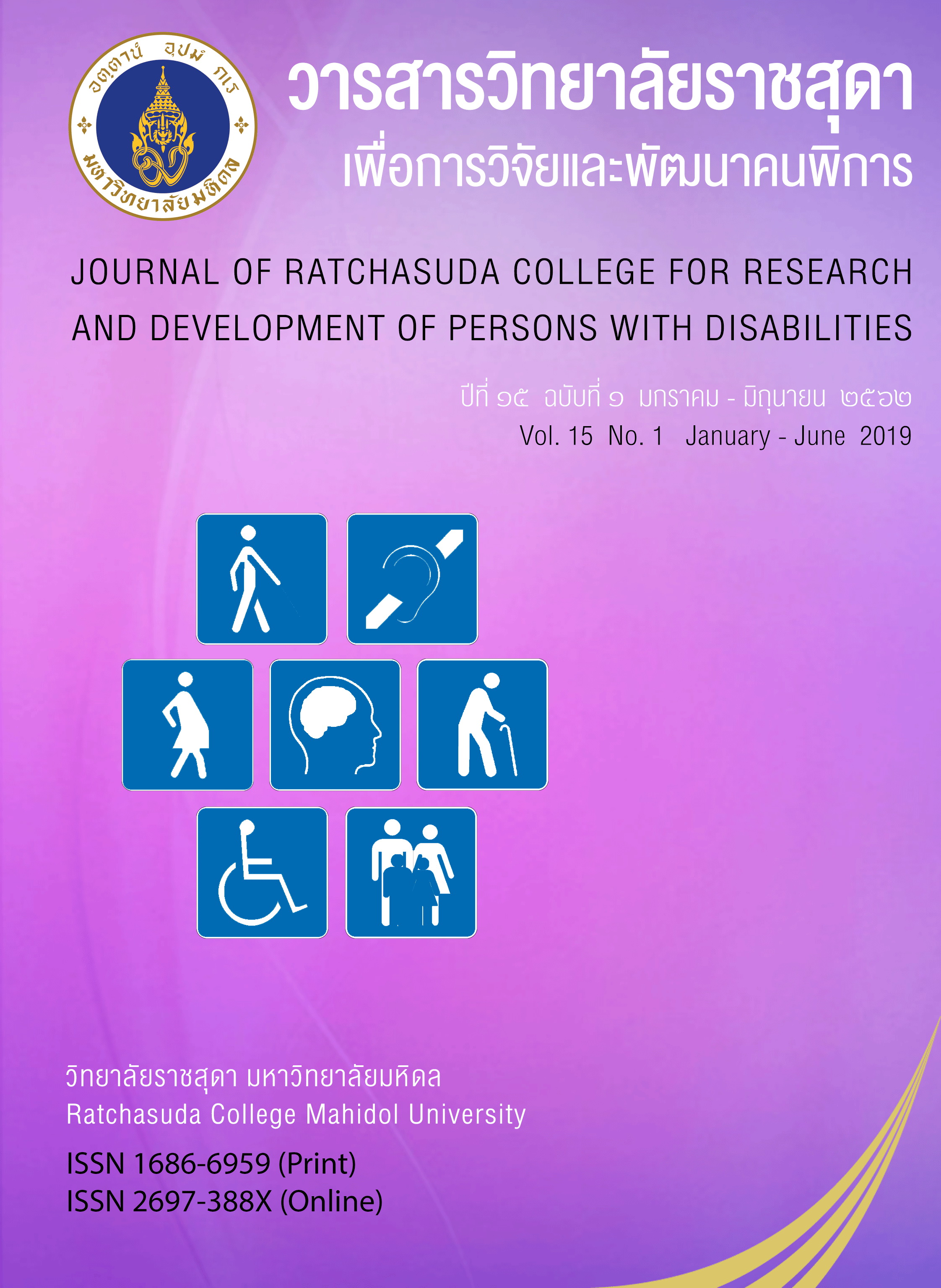การพัฒนารูปแบบความร่วมมือของผู้ปกครองเพื่อจัดการเรียนรู้ต่อความฉลาดทางอารมณ์และผลทางการเรียนของนักศึกษาที่มีความบกพร่องทางการได้ยิน
บทคัดย่อ
การวิจัยครั้งนี้มีวัตถุประสงค์เพื่อ 1) ศึกษาลักษณะทางกายภาพ ความฉลาดทางอารมณ์ และผลทาง การวิจัยครั้งนี้มีวัตถุประสงค์เพื่อ 1) ศึกษาลักษณะทางกายภาพ ความฉลาดทางอารมณ์ และผลทางการเรียนของนักศึกษาที่มีความบกพร่องทางการได้ยินในระดับอุดมศึกษา 2) พัฒนารูปแบบความร่วมมือของผู้ปกครองในการจัดการเรียนการสอนของนักศึกษาที่มีความบกพร่องทางการได้ยิน และ 3) ศึกษาผลการใช้รูปแบบความร่วมมือของผู้ปกครองในการจัดการเรียนการสอนต่อความฉลาดทางอารมณ์และผลทางการเรียนของนักศึกษาที่มีความบกพร่องทางการได้ยิน ระยะแรกเก็บรวบรวมข้อมูลจากผู้ที่มีความบกพร่องทางการได้ยินระดับปริญญาตรี จำนวน 207 คน ระยะที่สองเก็บข้อมูลจากการสัมภาษณ์เชิงลึกนักวิชาการและผู้ปกครอง จำนวน 17 คน เพื่อหารูปแบบที่เหมาะสม และระยะที่สามเป็นการทดลองใช้รูปแบบความร่วมมือของผู้ปกครองในการจัดการเรียนการสอนกับผู้ปกครองและนักศึกษาที่มีความบกพร่องทางการได้ยิน จำนวน 10 คน เป็นเวลา 8 สัปดาห์ ผลการวิจัย พบว่า 1) กลุ่มตัวอย่างที่มีความบกพร่องทางการได้ยินมีความเห็นว่าปัจจัยด้านบริบทของครอบครัวมีผลต่อการเรียนรู้สูงสุด รองลงมาคือด้านสถานศึกษาและด้านความช่วยเหลือตามลำดับ ความฉลาดทางอารมณ์อยู่ในระดับปกติ 5 ด้าน และต่ำกว่าเกณฑ์ 4 ด้าน คือ ด้านเห็นใจผู้อื่น ความรับผิดชอบ สัมพันธภาพและความพอใจชีวิต 2) ผลการพัฒนารูปแบบความร่วมมือของผู้ปกครองในการจัดการเรียนการสอนของนักศึกษาที่มีความบกพร่องทางการได้ยินได้รูปแบบประกอบด้วย 4 มิติ คือ ความร่วมมือของกลุ่มบุคคล สัดส่วนและวิธีการสื่อสารเพื่อส่งเสริมและแสวงหาความรู้ เนื้อหาสาระที่จะนำมาเพื่อสร้างความร่วมมือ และปัจจัยสนับสนุนการสร้างเครือข่าย 3) ผลการทดลองใช้รูปแบบความร่วมมือ พบว่า ผู้ปกครองของนักศึกษาที่มีความบกพร่องทางการได้ยินมีการติดต่อสื่อสารระหว่างภายในกลุ่ม ความสามารถและพฤติกรรมการใช้เครือข่ายสังคมออนไลน์และพฤติกรรมการเรียนรู้ของผู้ปกครองเพิ่มขึ้นทุกด้าน นักศึกษาที่มีความบกพร่องทางการได้ยินมีระดับความฉลาดทางอารมณ์ด้านการมีแรงจูงใจเพิ่มขึ้นและมีคะแนนผลสัมฤทธิ์ทางการเรียนวิชาการพัฒนาทรัพยากรสารสนเทศเพิ่มขึ้น
Downloads
References
Arayawinyu, P. (1999). Study for the disabilities. Bangkok: Waengaew.
Calderon, R., & Greenberg, M. T. (2003). Social and emotional development of deaf children: family, school and program effects. in Marschark, M. and Spencer, P.E. (Eds.) The Oxford handbook of deaf studies, language, and education. New York, NY: Oxford University Press.
Cavender, A. (2010). Collaborative, multimedia solutions for improving educational access for deaf and hard of hearing learners. Ph.D. dissertation, University of Washington, United States Washington. Retrieved from Dissertations & Theses: Full Text. (Publication No. AAT 3421543).
Department of empowerment of persons with disabilities. (2017). The disabled in Thailand, August 2017. Retrieved May 4, 2018, from https://www.m-society.go.th/ ewt_ news. php?nid=20586.
Department of Mental Health. (2000). The development of Thai emotional intelligence screening test for ages 12-60. Bangkok: Department of Mental Health.
Draper, L., & Duffy, B. (2007). Working with Parents. In Contemporary Issues in the Early Years. Great Britain: Cromwell Press.
Epstein, J. (2002). Six types of involvement: keys to successful partnerships. National Network of Partnership Schools, John Hopkins University, Baltimore. Retrieved December 1, 2015, from http://www.csos. jhu.edu/P2000/nnps_model/school/sixtypes.htm.
Falloon, G. (2013). Young students using iPads: app design and content influences on their learning pathways. Computers and Education, 68, 505-521.
Franklin, P. E. (2010). Perforating Tympanic Walls: A Second Look at Identity Politics In Relation to the 1988 and 2006 Protests at Gallaudet Unversity. Proquest Dissertations and Theses, Publication Number, AAT3390324.
Joyce, B., & Weil, M. (1996). Model of teaching. (5th ed). Boston: Allyn and Bacon.
Khemmani, T. (2007). The model of Instructions. Bangkok: Chulalongkorn University.
Luckner, J. L. & Cooke, C. (2010). A summary of the vocabulary research with students who are deaf or hard of hearing. American Annals of the Deaf, 155(1), 38-65.
Mankus, A. M., Boden, M. T., & Thompson, R. J. (2016). Sources of variation in emotional awareness: Age, gender, and socioeconomic status. Personality and Individual Differences, 89, 28-33.
Mayer, J., Roberts, R., & Barsade, S. (2008). Human abilities: emotional intelligence. Annual Review of Psychology, 59(1), 507-536.
Meadow-Orlans, K. P. & Steinberg, A. (1993). Effects of infant hearing loss and maternal support on motherinfant interactions at 18 months. Journal of Applied Developmental Psychology, 14, 407–426.
Nayong, S. (2010). The development of an instructional model for hearing impaired undergraduate students in higher education institutions. (Unpublished doctoral dissertation). Chulalongkorn University, Bangkok, Thailand.
Office of the Higher Education Commission. (2015). Annual report for the year 2015. Bangkok: Office of the Higher Education Commission.
Phoomisittiporn, A. (2007). A study on problems and needs of students with hearing impairment in rajabhat universities. (Unpublished master’s thesis), Srinakharinwirot University, Bangkok, Thailand.
Sarakitprija, V. (2011). A Study of the Relationship between Characteristics of Parents and Parent Involvement Behaviour in Promoting Children’s Learning at Kukai Kindergarten School, Klongtoey, Bangkok. (Unpublished master’s thesis), Srinakharinwirot University, Bangkok, Thailand.
Schirmer, B. R. (2001). Psychological. Social, and Educational Dimensions of Deafness. Ohio: Kent State University.
Song, L. J., Huang, G-H., Peng, K. Z., Law, K. S., Wong, C-S., & Chen, Z. (2010). The differential effects of general mental ability and emotional intelligence on academic performance and social interactions. Intelligence, 38(1), 137-143.
Suntonanantachai, T. (2010). Rights liberty and equality of higher education for persons with disabilities: A case study of persons with hearing impairment. (Unpublished master’s thesis), Chulalongkorn University, Bangkok, Thailand.
Tableman, B. (2004). School climate and learning. Best Practice Briefs, 31, 1-10.
Theunissen, S. C., Rieffe, C., Netten, A. P., Briaire, J. J., Soede, W., & Kouwenberg, M. (2014). Self-esteem in hearing-impaired children: the influence of communication education, and audiological characteristics. PloS One, 9(4), 494-521.
Thongsawang, T. (2006). Sociology. Bangkok: O.S. Printing House.
Thongyurai, P. & Maneemungkung, H. (2008). Development of social adjustment by applying Buddhism and local cultural concept among students with hearing disability. Songkhla:
Faculty of Nursing Prince of Songkla University.
Weng, H. C. (2008). Does the physician’s emotional intelligence matter? Impacts of the physician’s emotional intelligence on the trust, patientphysician relationship, and satisfaction. Health
care management review, 33(4), 280-288.
Westmoreland, H. (2009). Family Involvement Across Learning Setting. Harvard Family Research Project. Retrieved August 17, 2015, from http://www.hfrp.org.
Williamson, C. E. (2003). A Resilience Model for Transition of African American Deaf and Hard of Hearing Students Through Four-Year Post-Secondary Programs. Dissertation Abstracts
International, 64(9), 3160.
World Health Organization. (2015). Deafness and hearing loss. Retrieved May 10, 2015, from http://www.who.int/media-centre/factsheets/fs 300/en.
Zeidner, M., Matthews, G., & Roberts, R. D. (2012). The emotional intelligence, health, and well-being nexus: What have we learned and what have we missed. Applied Psychology: Health and Well-being, 4, 1-30.
Downloads
เผยแพร่แล้ว
How to Cite
ฉบับ
บท
License
บทความที่ได้รับการตีพิมพ์เป็นลิขสิทธิ์ของวารสารสถาบันราชสุดาเพื่อการวิจัยและพัฒนาคนพิการ





